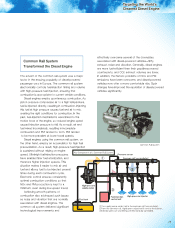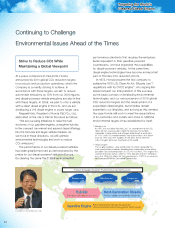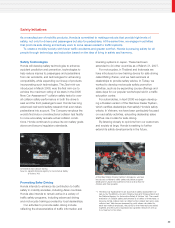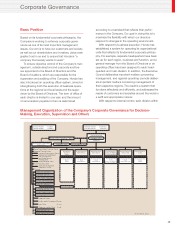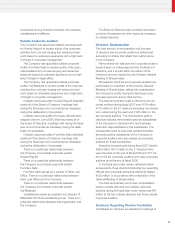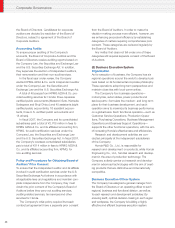Honda 2007 Annual Report Download - page 40
Download and view the complete annual report
Please find page 40 of the 2007 Honda annual report below. You can navigate through the pages in the report by either clicking on the pages listed below, or by using the keyword search tool below to find specific information within the annual report.
38
3. Promotion of Alternative Fuel-Powered
Vehicles
• North America (the United States)
In 2005, we were the first company in the world
to lease a fuel cell vehicle to an individual owner.
Honda’s track record now extends to 23 FCX fuel cell
vehicles leased in North America (a total of 34 leases
of the FCX in Japan and the United States). In 2007,
we also delivered one of these vehicles to American
actress Q’orianka Kilcher. In Torrance, California, we
are converting natural gas to hydrogen and using the
hydrogen to power fuel cell vehicles. We are in the
process of testing hydrogen fueling stations, such as
the Home Energy Station, which also provides hydro-
gen to generate heat and electric power in homes.
We have substantially enhanced the power and
highway fuel economy of the third generation natural
gas-powered Civic GX, following the first-generation
in 1998 and the second-generation in 2001. As these
vehicles have advanced, we have offered affordable
a home refueling appliance for natural gas-powered
vehicles. Honda is thus playing a leading role in
promoting alternative fuel-powered vehicles.
• Other Regions (Brazil)
In Brazil, where ethanol produced from sugar cane is
commonly used as fuel, since the mid-1980s Honda
has offered motorcycles and automobiles that run on
a mixture of ethanol and gasoline. The ethanol ratio of
fuels in Brazil is increasing, and a 100% ethanol
fuel—E100—is now available. To meet this challenge,
Honda introduced flex-fuel models of the Civic in
November 2006 and the Fit in December, both of
which can operate on any gasoline–ethanol mixture.
For further details on Honda’s environmental activities, please refer to Honda’s Environmental Report 2007.
URL: http://www.honda.co.jp/environmental-report/2007/
Freewatt, manufactured by Climate Energy, LLC
(Honda’s cogeneration unit at left)
• Other Product Deployment
Since Honda released its home-use cogeneration unit
in Japan in March 2003, total unit sales through gas
companies have reached 45,000. In March 2007, the
Company launched Freewatt, a compact home-use
cogeneration system developed in cooperation with
Climate Energy, LLC, in North America. We began
sales in the cold northeastern United States and aim
to expand into other cold regions of the country.
*1: EPA
The U.S. Environmental Protection Agency
*2: TierII Bin5
This standard for exhaust emissions was established in the United
States by the Environmental Protection Agency based on the U.S.
Clean Air Act and went into effect in 2004. Regulating the value of
NOx for emissions category BIN5: 0.07g/mile. To meet TierII Bin5
standards, we have cut emissions by 75% or more from the
previous levels.
*3: Diesel particulate filter (DPF)
This ceramic filter attracts and strains out black smoke and other
particulate matter from the exhaust of diesel vehicles, cleaning
their emissions.
*4: Euro4
Emissions regulations implemented in Europe from 2005. Although
China and many Asian countries have introduced European regula-
tions, at present they only require compliance with Euro3 standards.
Euro4 is a stringent level that Thailand is considering adopting
from 2008.
*5: Honda IMA (Integrated Motor Assist)
A new hybrid system developed independently by Honda. While the
engine is the primary power source, an electric motor will assist dur-
ing acceleration. Due to a design that is more simple than a conven-
tional hybrid system, a structure that is both lighter weight and more
compact in size was achieved. Using energy efficiently, this new
hybrid system achieves high fuel efficiency during both city and
highway driving.
Environment and Safety



